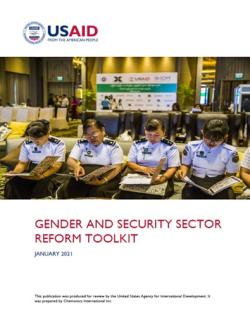Over the past two decades, distinct approaches to Security Sector Reform (SSR) emerged to address the evolving international security environment. The UN’s 2030 Agenda for Sustainable Development recognizes that good governance of the security sector and “leaving no one behind” mean that the security needs of all are taken into account and all must have access to justice. In all contexts globally, women and girls are affected by insecurity, harmful practices, violence, and conflict. Measures that ensure gender equality are integral to effective rule of law, guarantee access to justice for all, and engender accountable and inclusive institutions.
Gender is the way in which cultural and social norms — which are fluid and can change by context, country, and time — influence what it means to be a man, woman, boy, or girl in any given society. The integration of a gender perspective into the Security Sector is obligated by UN Security Council Resolution 1325 and numerous other international legal frameworks and commitments. Composed of a wide range of military, maritime security, police, court, legal, prison, and parliamentary and civilian oversight institutions; the Security Sector must ensure their services are benefitting women and girls equally to men and boys.
Being adaptive, the DRG Center published the USAID Gender and Security Sector Reform Toolkit to assist Program Managers incorporate gender considerations into SSR program design. Within the SSR field, gender issues are recognized as key to enhancing local ownership; ensuring good governance, accountability, and respect for human rights; and providing effective service delivery. Mainstreaming gender issues in SSR programming and increasing women’s participation and leadership in security institutions are necessary for ensuring equal opportunity to participate in, and benefit from, the security sector. The integration of gender approaches into SSR is a prerequisite to increasing the effectiveness and accountability of security institutions to benefit all members of society.
One does not need to be a security sector expert or a gender expert to lead a thoughtful security sector reform program design that incorporates gender considerations. This page provides the complete USAID Gender and Security Sector Reform Toolkit and a summary Learning Digest to support the incorporation of gender into your security program design.

